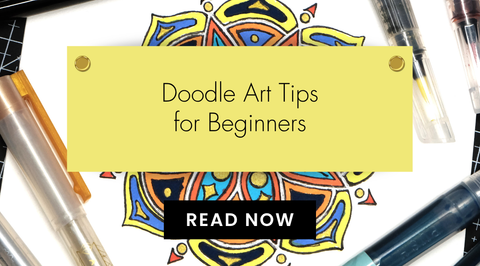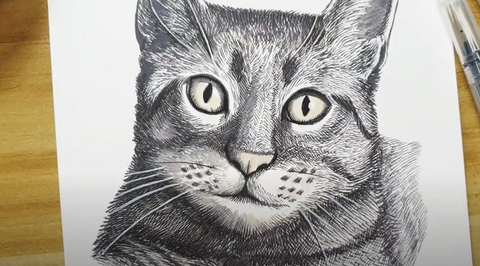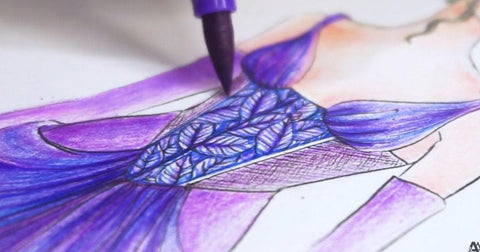Composition in Art: Creating A Balanced and Harmonious Artwork
Last Updated: July 29, 2024

“Good composition [in art] is like a suspension bridge — each line adds strength and takes none away.” – Robert Henri
The concept of composition in art is akin to the foundation of a masterpiece. It is the invisible force that guides the viewer's eye and evokes emotions. Understanding the art of composition is crucial for any artist looking to create balanced and harmonious artwork.
Today, let’s delve into tips and techniques that will elevate your artwork to new heights.
Rule of Thirds

The Rule of Thirds is a foundational principle in visual composition that divides an image into a 3x3 grid, creating nine equal sections.
The basic idea is to place key elements of the composition along these gridlines or at their intersections, creating a more dynamic and visually appealing arrangement. This technique is widely used in various art forms, including painting, photography, and graphic design.
1. Focal Points and Balance
By placing the main elements or focal points of your composition along the gridlines or at the intersections, you naturally guide the viewer's gaze. This not only adds interest but also creates a sense of balance within the artwork.

2. Avoiding Centered Compositions
Placing the main subject in the center of the frame can sometimes result in a static and less engaging composition. The Rule of Thirds encourages artists to break away from this centered approach, fostering a more dynamic and visually interesting layout.
3. Creating Tension and Movement
Placing elements along the gridlines or intersections introduces a sense of tension and movement. This can be particularly effective in compositions where the viewer's eye is led along a path or through a series of connected elements.

4. Symmetry and Asymmetry
While the Rule of Thirds often emphasizes asymmetry, it can also be used to achieve balanced symmetry by placing elements along corresponding gridlines. Artists can experiment with both symmetrical and asymmetrical arrangements to convey different moods and aesthetics.
|
Pro-tip: Experiment with asymmetry by placing your main elements off-center to create a visually compelling arrangement.
|
5. Rule of Thirds and Golden Ratio
While the Rule of Thirds is a widely recognized and simple guideline, it shares some conceptual similarities with the more complex Golden Ratio. Both aim to create aesthetically pleasing proportions, and artists often find ways to combine elements of both rules for optimal composition.
Negative Space
Negative space, often referred to as "white space" in design, is a crucial aspect of visual composition that involves the deliberate use of empty or unoccupied areas in an artwork.

But don't underestimate the impact of these seemingly vacant spaces! While it may seem like the absence of content, negative space plays a pivotal role in shaping the overall composition and can greatly influence the viewer's perception.
For one, it provides breathing room and balance within your composition. For another, it can be used to highlight and emphasize the main subject of the artwork; drawing attention to the focal point and allowing it to stand out more prominently. Play with negative space to emphasize your primary elements and evoke a sense of calm or tension.
|
Pro-tip: Consider negative space as an active participant in your composition, not merely an empty void. |
Color Harmony

For artists attuned to color theory, achieving harmony in your palette is paramount. Experiment with analogous or complementary color schemes to create a cohesive and visually pleasing composition. Balance warm and cool tones strategically to evoke specific moods and emotions.

|
Pro-tip: Use the 60-30-10 rule, where 60% of your composition is dominated by a primary color, 30% by a secondary color, and 10% by an accent color. |
Learn More About the Power of Color With Our Coloring Classes!
Leading Lines
Leading lines are a powerful compositional tool in visual arts that guides the viewer's gaze through an image, creating a sense of flow and direction. By strategically incorporating lines—either actual or implied—artists can influence how the audience perceives and engages with their work.

Types of Leading Lines
- Actual Lines — These are real, tangible lines within the composition. Examples include roads, rivers, bridges, or any other physical lines that naturally occur in the scene.
- Implied Lines — These are suggested or imaginary lines created by the arrangement of elements in the composition. For instance, a row of trees, the gaze of a subject, or a sequence of objects can imply a line that leads the viewer's eye.
Guiding the Viewer's Eye
Leading lines serve as visual pathways, directing the viewer's attention to specific areas of interest within the artwork. Artists can use these lines to guide the audience through the composition, telling a visual story and creating a sense of movement.
Artists and creatives can also adapt leading lines to suit the characteristics of their art medium. For example, photographers often find natural leading lines in landscapes, while painters may create them with brushstrokes or composition choices.
Creating Perspective and Immersion
Incorporating leading lines adds depth to a two-dimensional image. The lines draw the viewer's eye into the scene, creating a sense of perspective and immersion. This is particularly effective in landscape and architectural compositions.

- Experimenting with Line Types – Artists can experiment with different types of lines to achieve specific effects. Curved lines can soften the composition, while jagged or angular lines can introduce a dynamic and edgy quality.
- Intersection Points – Where leading lines intersect can be crucial. These intersection points often become focal points in the composition, drawing additional attention. Placing significant elements at these intersections can enhance the overall impact of the artwork.
- Organic vs. Geometric Lines – Leading lines can be organic, flowing naturally within a scene, or geometric, created by man-made structures. Combining both types can result in visually interesting compositions that balance the organic beauty of nature with the precision of human design.
|
Pro-tip: Diagonal lines can inject energy and movement into your composition, making it more visually engaging. |
Depth and Layers

Adding depth to your artwork enhances its visual appeal. Create layers within your composition by incorporating foreground, middle ground, and background elements. This technique provides a sense of dimension, drawing the viewer into the world you've crafted.
|
Pro-tip: Overlapping elements and varying sizes help establish a sense of depth, making your composition more immersive. |
Discover More Creative Ideas and Artistic Inspiration Here!
Mastering the art of composition involves a delicate dance between various elements, each contributing to the overall harmony of the piece. As you explore these tips and techniques with the eye of an artist, remember that rules are meant to be bent and broken.
Final tip: Embrace your creative intuition, experiment with different compositions, and discover the unique visual language that defines your artwork. The journey to creating balanced and harmonious compositions is a dynamic and ever-evolving process—one that will undoubtedly leave a lasting impression on both you and your audience.






